Oct 17, 2025
Oct 17, 2025
Trade to Empire – From the East India Company to Angrez Raj
"In the middle of the seventeenth century, Asia still had a far more important place in the world than Europe." So wrote J. Pirenne in his 'History of the Universe', published in Paris in 1950. He added, "The riches of Asia were incomparably greater than those of the European states. Her industrial techniques showed a subtlety and a tradition that the European handicrafts did not possess. And there was nothing in the more modern methods used by the traders of the Western countries that Asian trade had to envy. In matters of credit, transfer of funds, insurance, and cartels, neither India, Persia, nor China had anything to learn from Europe." (Quoted in Auguste Toussaint's 'History of the Indian Ocean')
The British East India Company made its presence felt in India in the 17th century, during the height of power of the Mughal empire. Instead of selling their own goods, the British eventually found it more profitable to sell Indian goods in Europe. The early days were hard. There was competition from both other Europeans, as well as other trade routes (the Red Sea route through Egypt, the Persian Gulf Route through Iraq, and the Northern Caravan Route through Afghanistan, Persia and Turkey). Thus the early British Traders were in no position to dictate terms and trade concessions were hard won. However, eventually and with perseverance the Company slowly established trading bases wherever it could along either side of the lengthy Indian coastline.
As the East India Company slowly changed in character from a purely trading concern to a political-military-economic machine, it was these trading bases that formed the nucleus of British settlements and it was here that the first British buildings came up. In keeping with the nature of the Company, the first buildings were warehouses, barracks and living quarters, protected by a fort.
The earliest British forts followed Portuguese and French variations of the Italian Renaissance’s conception of an ideal city and its defenses. In the forts at Madras and Calcutta, the French military engineer Vauban’s influence is apparent. Regular polygonal geometry and salient triangular bastions with recessed flanks at each angle maximized all-round cover and minimized vulnerability by offering overlapping fields of fire. Ditches and earthworks between the main ring of bastions and lower, outlying salients increased defensive capability. The area surrounding the fort was cleared of all obstacles so as to remove any cover for attackers.
These first forts at Madras, Bombay and Calcutta were the principal seats from where the Company oversaw its affairs. Features common to them all include doubled walls and angular bastions for artillery to dominate the approach. The fortifications also took advantage of natural features like the sea and rivers for defense.
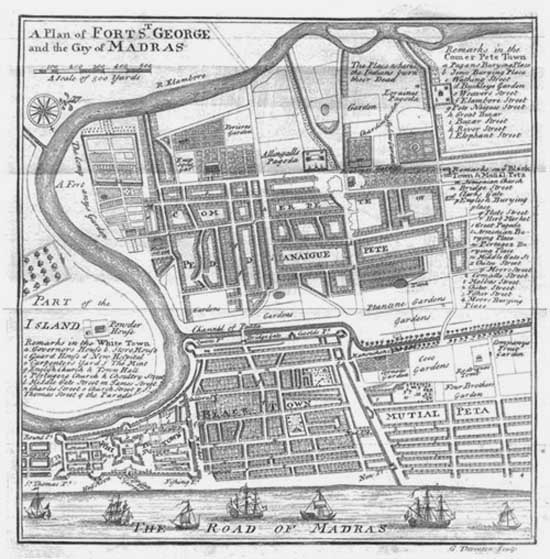
Plan, Madras City, showing Fort St. George in lower left
Around the forts the first signs of segregation were already apparent – the European and Indian communities lived in separate settlements with very distinct characters. In the case of Fort St. George, Madras, the main fortifications surrounded the warehouses and other military buildings, and the so-called ‘white town’ had another ring of fortification separating it from the ‘black town’.
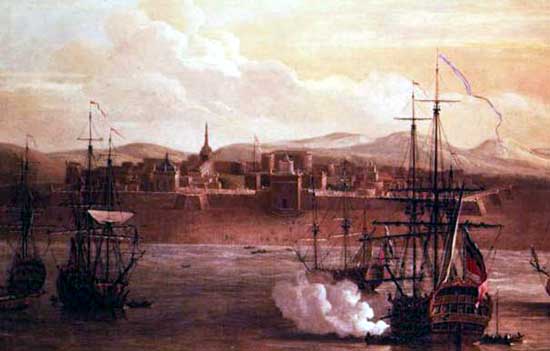
Fort St. George, Madras
Bombay’s Fort St. George was finished in 1715. To place this in context, the Mughal empire was beginning to rapidly come apart with Aurangzeb’s death in 1707.
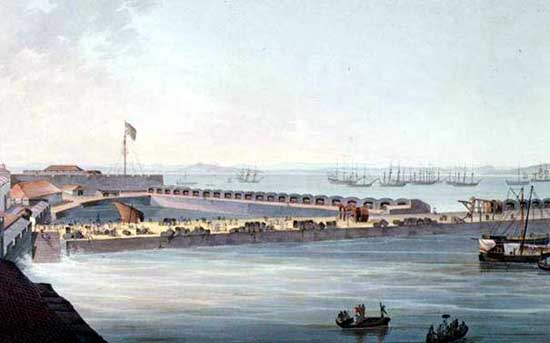
Fort St. George, Bombay
Although Fort St. George Madras was one of the first British outposts, it fell to the French in 1745, and again in 1758, before it was finally retaken by the British. The French were also weakened by their losses in Europe and were slowly abandoning India to the British.
After the Nawab of Bengal took Calcutta in 1755 and was then defeated by Clive, a new Fort William was begun by the Company’s chief engineer in Bengal, Captain John Bohier. On an island site by the river unencumbered by buildings, Fort William’s field survives as the maidan, emulated at Bombay.
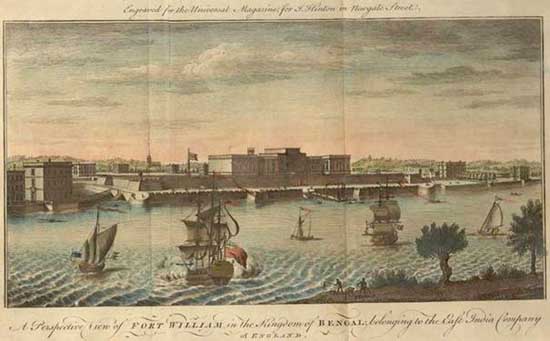
Fort William, Calcutta
In addition to warehouses within the fort walls, there was also the need for arsenals, barracks and residential accommodation for the British. A church, too, was a necessity. The first English church in India was thus St. Mary’s at Madras fort, founded in 1678.
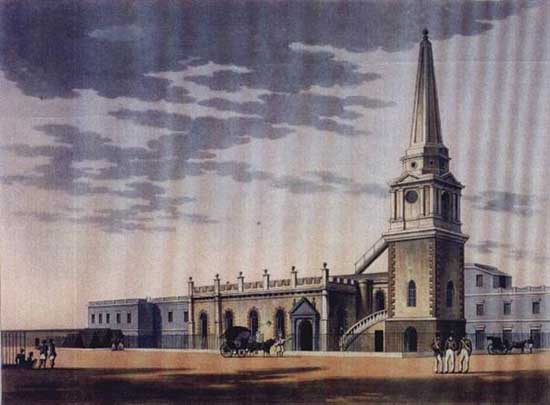
St. Mary's Church, Madras
05-Jun-2004
More by : Ashish Nangia

|
Dear Ashish Nangia Fascinating to read your short article. I found it in my continuing search for a sense of life in Calcutta in the 1890's - actually my interest more form the perspective of everyday life. The search stems from my interest in my fathers sojourn in Calcutta between 1892-7 when he was a medical student there (from Ceylon) He is reputed to be the first Asian doctor to train in England but no one knows for sure Obviously architecture reflects human aspirations and so the link Best wishes David Bethesda Maryland USA |